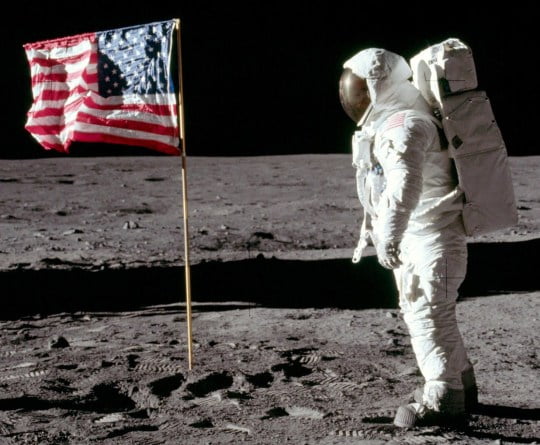The global commendations poured in as China’s Chang’e-5 probe successfully planted a flag on the surface of the moon, becoming the first country since the 1972 US Apollo missions to achieve such a feat.
China Commissions More J-16 Fighter Jets To Counter Growing Indian Fleet Of Rafales, Su-30 MKIs
Some media reports have termed China as being only the second nation to have its flag on the surface of the moon. But is it? Even though the United States was the first and only nation to have sent its astronauts to the moon and back, the Soviet Union was the first to send a probe to the moon’s surface.
In 1957, the Soviets shocked their rivals by sending the first-ever satellite into the earth’s orbit using their R-7 intercontinental ballistic missile (ICBM).
Called the Sputnik, the launch of the satellite terrified the Americans at the time thinking the Soviets had invented a new way of attacking them from space. The US’ lead on scientific advancement immediately came into question as the Russians had started achieving one feat after another in the space domain.
The Americans responded soon with the launch of their first satellite, however, they were yet to overtake the Russians in their swift progress. The Soviet Union took another step forward in its space program in 1959 when they launched the Luna-2 probe to hit the moon.
The country then sent its cosmonaut Yuri Gagarin to space in April 1961, who became the first person to orbit the Earth, traveling in the capsule-like spacecraft Vostok 1.

Luna-2 became the first man-made object sent from earth to reach the lunar surface. The spacecraft crash-landed on the surface of the moon, which was pre-planned, carrying the Soviet flag along with it.
Technically, the Soviet flag was the first to reach the surface of the moon, where no man or machine had ever been before.
The event gave the Soviets a tremendous advantage in the space race, prompting their cold-war rival, the US, to develop their own space program.
With their inexorable space march during the 1950s, the communist Soviet Union had not only demonstrated their outer-space capabilities but most importantly, the devastating power of their ICBM missiles, which at the time were simply unstoppable.
The trembled Americans devoted all their resources to send the first humans to the moon, with the US president at the time, John F. Kennedy, resolving to land a man on the moon before the end of the decade.
He increased NASA’s budget by a whopping 500 percent, deploying more than 34,000 employees towards the lunar program.

In 1969, the country finally succeeded in landing the first men on the moon, with Neil Armstrong becoming the first person to set a foot on the lunar surface. The Russian space program had, meanwhile, suffered many setbacks and the US started to ultimately beat them to the moon with a manned mission.
The picture of Neil Armstrong planting the American flag on the lunar surface generated huge applause around the world, while the secret Soviet Luna-2 mission was relegated to history. The US sent five more manned missions to the moon in a span of just three years.
However, after the 70s, the US realized it had achieved its mission of defeating the Soviets in the space race and its interest in new launches started waning. With the exorbitant capital required to undertake such missions, there were no manned missions to the moon after the last astronauts went to the moon in 1972.
The China Story
The 21st century gave rise to a new power – China. The communist nation has been leapfrogging in the space race in the last two decades with a plethora of achievements.
Led by a strong R&D budget and a government resolute on emerging as the new superpower, the country has already sent three missions to the moon, which have all been successful.
China has made exceptional progress in its lunar mission and currently has seven operational spacecraft on or around the Moon: Chang’e-3 lander, Chang’e-4 lander and Yutu-2 rover, Queqiao relay satellite, CE-5 T1 orbiter, CE5 orbiter, and CE-5 lander/ascent vehicle. No other country has an operational rover on the surface of the moon at present.
There's now a full fabric PRC flag planted on the surface of the Moon after it was deployed from one side of Chang'e 5's descent stage just before ascent stage's launch.
Whatever your opinions on the PRC are, this photo definitely has significant meanings in spaceflight history. pic.twitter.com/um1xR2brRg
— Cosmic Penguin (@Cosmic_Penguin) December 4, 2020
The country’s Chang’e-4 spacecraft made history when it landed on the far side of the moon in January 2019, the only one to do so. The country also landed Chang’e-3 in December 2013 which incorporates a robotic lander and China’s first lunar rover.
The latest audacious Chinese mission, Chang’e-5 aims to bring back lunar soil from the surface of the moon and has successfully landed and taken off from its surface.
Apart from its multiple missions to the moon, the country this year set its eyes on the red planet, sending its first-ever 5000-kg Tianwen-1 spacecraft to Mars.
Blasting off from the Wenchang Satellite Launch Center aboard a Chinese Long March-5 rocket on 23 July, the craft contains a lander, orbiter, and rover.
The critics are already rewriting China as the new global superpower, with the US having lost both the capacity and the will to hold on to its superpower status.




